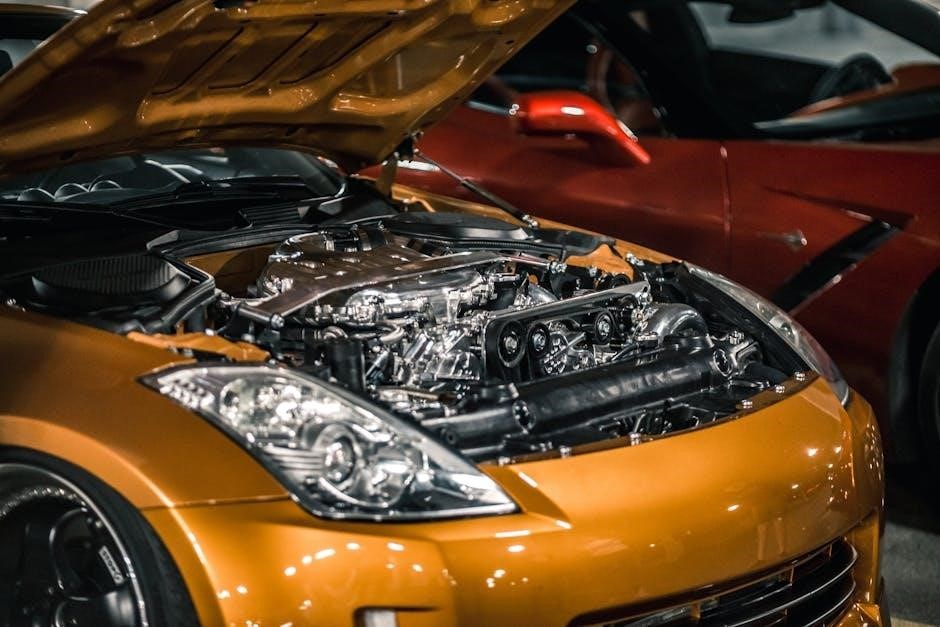A “Headlight System Error” indicates a malfunction in your vehicle’s lighting system, often caused by electrical issues, faulty components, or sensor problems, requiring prompt attention for safety and legal compliance.
1.1 Understanding the Error Message
The “Headlight System Error” message signals a potential issue with your vehicle’s lighting system. It may appear due to faulty bulbs, electrical malfunctions, or sensor problems. While the headlights might still function, the error indicates an underlying problem that needs attention. Consulting the owner’s manual or a professional is essential to diagnose and resolve the issue, ensuring safety and preventing further complications. Ignoring this warning could lead to reduced visibility or system failure while driving.
1.2 Importance of Addressing the Issue
Addressing the “Headlight System Error” is crucial for maintaining road safety. Malfunctioning headlights can reduce visibility, increasing the risk of accidents, especially at night or in low-light conditions. Ignoring the issue may lead to further damage to electrical components or sensors. Prompt action ensures proper illumination, compliance with traffic laws, and prevents potential failures while driving. Regular inspections and timely repairs help maintain your vehicle’s reliability and safety on the road, safeguarding both you and other road users;

Common Causes of the Headlight System Error
The error often stems from electrical issues, faulty bulbs, corroded wiring, or blown fuses. Sensor malfunctions and damaged control modules can also trigger the system error.
2.1 Electrical System Issues
Electrical system issues are a primary cause of headlight system errors. Faulty wiring, corrosion, or loose connections can disrupt power supply to the headlights. Blown fuses or malfunctioning relays often contribute to the problem. Additionally, sensor failures or incorrect voltage readings may trigger the error. Addressing these electrical faults promptly ensures proper headlight functionality and safety on the road.
2.2 Faulty Headlight Bulbs or LEDs
Faulty headlight bulbs or LEDs are common causes of system errors. Burnt-out bulbs or malfunctioning LED arrays can trigger warnings, as the system detects a lack of proper illumination. Issues like dimming, flickering, or complete bulb failure often indicate a problem. Replacing damaged bulbs with genuine, compatible alternatives typically resolves the error. Always ensure correct wattage and type when replacing to maintain system functionality and avoid further complications.
2.3 Corroded or Damaged Wiring and Connections
Corrosion or damage to wiring and connections can disrupt the headlight system, leading to errors. Moisture, heat, or physical stress may cause wires to degrade, interrupting power flow. Inspecting connectors for rust or wear is essential. Cleaning or replacing corroded parts often resolves issues. Damaged insulation or frayed wires should be repaired promptly to restore proper electrical connections and ensure reliable headlight operation, preventing further system malfunctions or safety hazards while driving; Regular maintenance can help identify such issues early.
2.4 Blown Fuses or Faulty Relays
A blown fuse or faulty relay can trigger the headlight system error by interrupting power supply to the headlights. Fuses may blow due to excessive current, while relays can fail from wear or electrical surges. Checking the fuse box for blown fuses and replacing them with the correct rating is a common fix. If relays are malfunctioning, they may need to be tested or replaced. This issue is often straightforward to diagnose and repair, restoring proper headlight functionality quickly.
2.5 Malfunctioning Sensors or Control Modules
Malfunctioning sensors or control modules can trigger the headlight system error by disrupting communication within the lighting system. Modern vehicles rely on sensors to monitor headlight performance and adjust settings like adaptive lighting or automatic high beams. If these sensors fail or the control module develops issues, the system may detect anomalies and display an error message. In such cases, professional diagnosis is often required to identify and repair or replace the faulty components, ensuring proper system operation and safety on the road.

Troubleshooting Steps
Start by consulting the owner’s manual for guidance. Check fuses, relays, and wiring for damage or corrosion. Test voltage at the bulb socket to ensure proper power supply.
3.1 Checking the Owner’s Manual
The owner’s manual is the first step in diagnosing a headlight system error. It provides a clear, systematic approach to identifying issues, often including diagrams and specific instructions. By referencing the manual, you can understand the recommended troubleshooting steps for your vehicle, such as checking fuses or testing bulbs. This ensures you address the problem efficiently and correctly, reducing guesswork and potential damage. Always start here before moving to more complex diagnostic procedures.
3.2 Inspecting Fuses and Relays
Inspecting fuses and relays is a quick and cost-effective way to identify potential issues. Start by locating the fuse box, as indicated in the owner’s manual. Remove the fuse in question and inspect it for any signs of damage or blown circuits. Use a voltmeter to test for continuity. Similarly, check relays by swapping them with identical ones to see if the issue resolves. If a blown fuse or faulty relay is found, replace it with the correct specifications to restore functionality.
3.3 Testing Voltage at the Bulb Socket
Testing voltage at the bulb socket helps determine if the issue lies with the bulb or the electrical system. Turn on the headlights and use a voltmeter to check for power at the socket. A reading close to 12V indicates proper function. If voltage is present but the bulb doesn’t light, the bulb is likely faulty. If no voltage is detected, the problem may be in the wiring, fuse, or relay. This step helps isolate the root cause efficiently.
3.4 Examining Wiring and Grounds
Examining wiring and grounds is crucial for identifying connectivity issues. Inspect the headlight wiring for signs of damage, corrosion, or fraying. Use a multimeter to check for continuity and ensure proper grounding. Clean or replace corroded connections to restore electrical flow. Damaged or loose wires can disrupt power supply, causing the error. Grounds are especially important, as faulty ones can prevent the system from functioning correctly. Always refer to the wiring diagram in your owner’s manual for precise locations and connections.

Solutions and Repairs
Replace faulty bulbs, fuses, or wiring. Reset the system or consult a professional for complex issues. Addressing the root cause ensures proper headlight functionality and safety.
4.1 Replacing Faulty Components
Identify and replace damaged bulbs, fuses, or wiring. Use genuine replacements to ensure compatibility. If LED arrays or sensors are faulty, consider professional installation. Always refer to the manual for guidance to avoid further issues and maintain optimal headlight performance, ensuring safety and visibility on the road.
4.2 Resetting the System
Resetting the headlight system may resolve errors after replacing faulty components. This process often involves turning the ignition on/off or using a specific sequence outlined in the owner’s manual. It can eliminate the need for further repairs by recalibrating the system. Always ensure the reset procedure is followed correctly to restore proper functionality and avoid recurring issues.
4.3 Professional Diagnosis and Repair
When DIY methods fail, consulting a professional is crucial, especially for complex electrical or sensor-related issues. Mechanics use specialized tools to diagnose the root cause, such as faulty control modules or wiring. They can repair or replace damaged components, ensuring compliance with manufacturer standards. Professional intervention is recommended for persistent errors, warranty-covered vehicles, or when advanced technical expertise is required to restore the headlight system’s functionality safely and effectively. This ensures long-term reliability and avoids further complications.

Preventative Maintenance Tips
Regularly inspect headlights for damage or wear, clean electrical connections to prevent corrosion, and upgrade to reliable lighting solutions to minimize the risk of system errors.
5.1 Regular Inspection of Headlights
Regularly inspecting your vehicle’s headlights ensures early detection of issues like damaged bulbs, foggy lenses, or loose connections. Check for dimming, flickering, or uneven light output, which can signal potential problems. Clean lenses to maintain visibility and inspect wiring for signs of wear or corrosion. Addressing these issues promptly can prevent system errors and ensure optimal lighting performance for safer driving conditions. Consistent checks help maintain reliability and avoid sudden failures.
5.2 Cleaning and Protecting Electrical Connections
Clean and protect electrical connections to prevent corrosion and wear, which can cause headlight system errors. Use a soft brush or cloth to remove dirt and debris from terminals and sockets. Apply a rust-inhibiting spray to protect against moisture and corrosion. Regular maintenance ensures reliable connectivity, preventing issues like dimming or flickering lights. Protecting these connections also extends the lifespan of your headlight system and enhances overall electrical performance for consistent illumination.
5.3 Upgrading to Reliable Lighting Solutions
Upgrading to reliable lighting solutions can significantly reduce headlight system errors. Consider replacing outdated bulbs with high-quality LED or HID options, which offer improved brightness and durability. Ensure compatibility with your vehicle’s electrical system to avoid flickering or dimming issues. Modern lighting solutions often include error-free operation and energy efficiency. Always check compatibility and consult your owner’s manual or a professional before making upgrades to ensure optimal performance and safety on the road.

When to Consult a Professional
Consult a professional if errors persist after DIY fixes, for complex electrical or sensor issues, or when warranty coverage requires dealer intervention to ensure proper resolution and safety.
6.1 Persistent Errors After DIY Fixes
If the headlight system error remains unresolved after attempting DIY repairs, it may indicate a deeper issue requiring professional expertise. Persistent problems suggest that the fault lies beyond basic fixes like replacing bulbs or checking fuses. In such cases, consulting a certified technician is crucial to diagnose and repair complex issues, ensuring your safety on the road and preventing further damage to the vehicle’s electrical or lighting systems.
6.2 Complex Electrical or Sensor Issues
Complex electrical or sensor-related problems with the headlight system often require specialized tools and expertise. Issues like faulty control modules, damaged wiring, or malfunctioning sensors may not be easily diagnosable through basic troubleshooting. In such cases, consulting a professional technician is essential to ensure accurate repairs and restore proper functionality to your vehicle’s lighting system, preventing further complications and ensuring safety.
6.3 Warranty and Dealer Recommendations
If your vehicle is under warranty, contacting an authorized dealer is crucial for addressing the “Headlight System Error.” Dealers have access to specialized diagnostic tools and can perform repairs according to manufacturer guidelines. Additionally, they can determine if the issue is covered under your warranty, potentially saving you costs. Always follow the recommendations outlined in your owner’s manual to maintain warranty validity and ensure any repairs are conducted by certified professionals for optimal results and compliance.

Common Misconceptions About the Error
Many believe the “Headlight System Error” is solely due to bulb failure, ignoring critical issues like wiring faults or sensor malfunctions that require professional attention for resolution.
7.1 Assuming It’s Always a Bulb Issue
One common misconception is that a headlight system error is always due to a faulty bulb. While bulbs can fail, the issue often stems from electrical problems, such as corroded connections, blown fuses, or malfunctioning sensors. Ignoring these underlying causes can lead to persistent errors and safety hazards. It’s crucial to inspect the entire system, including wiring and relays, to identify the root cause accurately and ensure proper repairs. DIY fixes may sometimes resolve the issue, but in complex cases, professional assistance is necessary to restore functionality and prevent future occurrences. Regular maintenance, such as cleaning connections and checking fuses, can help prevent these errors from arising. Additionally, upgrading to reliable lighting solutions, like LED bulbs with proper compatibility, can enhance system performance and reduce the likelihood of errors. Understanding the broader causes beyond just bulb failure ensures a more effective and lasting solution for headlight system errors. This approach not only saves time but also improves overall vehicle safety and reliability on the road.
7.2 Ignoring the Importance of Grounds
Overlooking the condition of electrical grounds is a common oversight when addressing headlight system errors. Grounds are essential for completing the circuit, and corrosion or damage can disrupt communication between components. Neglecting grounds may lead to intermittent errors or complete system failure. Always inspect grounding points during troubleshooting, as poor connections can mimic bulb or sensor faults. Cleaning and securing grounds is a simple yet effective step to resolve many issues. Regular maintenance of grounding systems ensures reliable headlight performance and prevents recurring errors, enhancing overall vehicle safety and functionality.
7.3 Overlooking System Resets
Many drivers overlook the importance of resetting their vehicle’s headlight system after repairs or replacements. Modern vehicles rely on electronic systems that may require recalibration. Failing to reset the system can lead to persistent error messages, even after fixing the issue. This oversight can result in unnecessary trips to the dealership or mechanic. Always consult the owner’s manual or a professional to ensure proper system reset procedures are followed, preventing prolonged operational issues and ensuring optimal headlight functionality.
The “Headlight System Error” can be a frustrating issue, but understanding its causes and solutions is key to resolving it effectively. Whether it’s a simple bulb replacement or a complex electrical problem, addressing the error promptly ensures safety and legal compliance. Regular maintenance, such as inspecting wiring and connections, can prevent future occurrences. If DIY fixes fail, consulting a professional is advisable. Always refer to the owner’s manual for specific guidance, as system resets or recalibrations may be necessary. Stay proactive to keep your headlights functioning optimally and ensure safe driving conditions.
